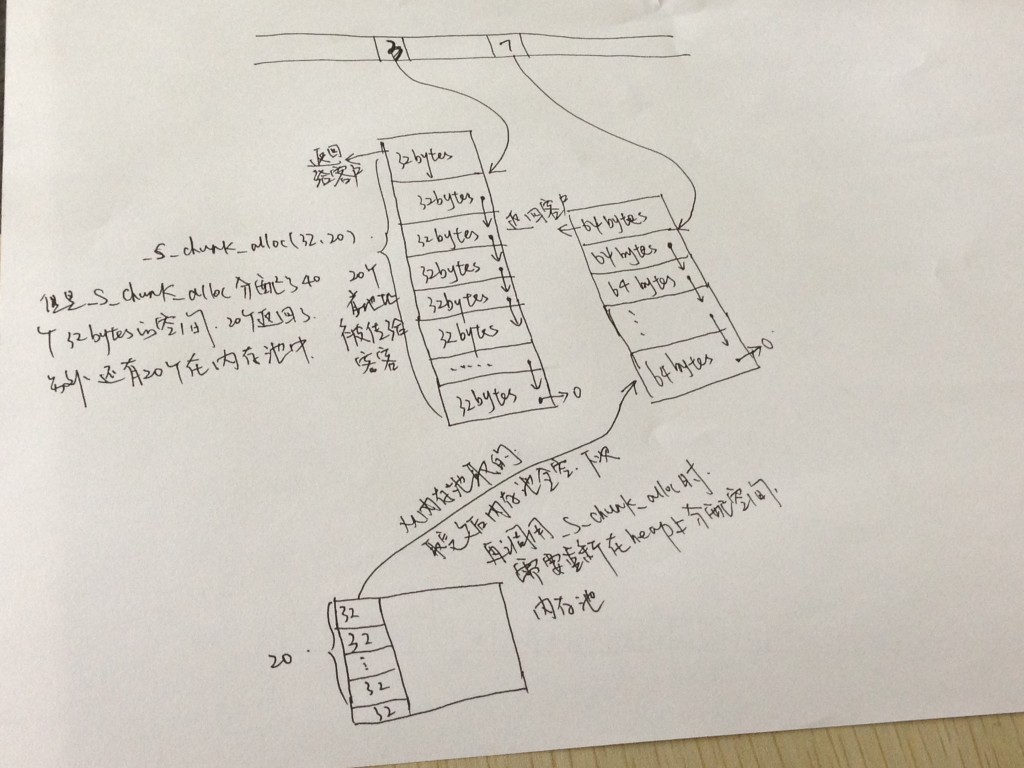在allocate函数中,当malloc_alloc::allocate分配失败后,就转向调用_S_refill。_S_refill函数的源代码:
template <bool __threads, int __inst>
void* __default_alloc_template<__threads, __inst>::_S_refill(size_t __n)
{
int __nobjs = 20;
char* __chunk = _S_chunk_alloc(__n, __nobjs); //取到了一块内存
_Obj* __STL_VOLATILE* __my_free_list;
_Obj* __result;
_Obj* __current_obj;
_Obj* __next_obj;
int __i;
if (1 == __nobjs)
return(__chunk);
__my_free_list = _S_free_list + _S_freelist_index(__n); //准备开始调整free list
/* Build free list in chunk */
__result = (_Obj*)__chunk; // 将此内块返回给客户
// 这下面的工作就是填充free list节点,将free list的节点指向内存块
*__my_free_list = __next_obj = (_Obj*)(__chunk + __n); //指向所分配内存下一个偏移地址
for (__i = 1; ; __i++)
{
__current_obj = __next_obj;
__next_obj = (_Obj*)((char*)__next_obj + __n);
if (__nobjs - 1 == __i)
{
<span style="white-space:pre"> </span>__current_obj -> _M_free_list_link = 0;
<span style="white-space:pre"> </span>break;
}
else
{
__current_obj -> _M_free_list_link = __next_obj; //链接自由链表串
}
}
return(__result); //然后返回所取到的那块内存给客户
}
__n已经被调整至8的倍数,_S_free_list是自由链表首地址,for循环所做的操作时调整free list指向。 内存分配时在_S_chunk_alloc函数中,该函数内所做的操作较多。以当前内存池的容量判断如何分配内存。_S_chunk_alloc函数的源代码:
template <bool __threads, int __inst>
char* __default_alloc_template<__threads, __inst>::_S_chunk_alloc(size_t __size,
int& __nobjs)
{
char* __result;
size_t __total_bytes = __size * __nobjs; //所需要的内存大小
size_t __bytes_left = _S_end_free - _S_start_free; //内存池剩余大小
if (__bytes_left >= __total_bytes) //如果池中剩余大小大于所需要的空间,那就把在线性内存中的区块分配给客户并返回,完成取内存操作
{
__result = _S_start_free;
_S_start_free += __total_bytes;
return(__result);
}
else if (__bytes_left >= __size) //如果池中剩余大小小于所需要的空间,但是还剩下至少一个__size大小,那就先把
{ //这一个分配出来,防止空间碎片和节约内存使用
__nobjs = (int)(__bytes_left/__size);
__total_bytes = __size * __nobjs;
__result = _S_start_free;
_S_start_free += __total_bytes;
return(__result);
}
else //如果连一个__size大小都没有
{
size_t __bytes_to_get = 2 * __total_bytes + _S_round_up(_S_heap_size >> 4); //要分配的内存大小,大于客户所需的内存
// Try to make use of the left-over piece.
if (__bytes_left > 0) //如果池中还有残留的小内存块,先将这个地址配置到free list中
{
_Obj* __STL_VOLATILE* __my_free_list =
_S_free_list + _S_freelist_index(__bytes_left);
((_Obj*)_S_start_free) -> _M_free_list_link = *__my_free_list;
*__my_free_list = (_Obj*)_S_start_free;
}
_S_start_free = (char*)malloc(__bytes_to_get); //开辟内存空间
if (0 == _S_start_free) //如果malloc失败了
{
size_t __i;
_Obj* __STL_VOLATILE* __my_free_list;
_Obj* __p;
// Try to make do with what we have. That can't
// hurt. We do not try smaller requests, since that tends
// to result in disaster on multi-process machines.
for (__i = __size;
__i <= (size_t) _MAX_BYTES;
__i += (size_t) _ALIGN)
{
__my_free_list = _S_free_list + _S_freelist_index(__i);
__p = *__my_free_list;
if (0 != __p) <span style="white-space:pre"> </span>//如果说free list中还有没有被使用的内存
<span style="white-space:pre"> </span>{
*__my_free_list = __p -> _M_free_list_link;
_S_start_free = (char*)__p;
_S_end_free = _S_start_free + __i;
return(_S_chunk_alloc(__size, __nobjs)); //反复递归调用,看被“挤”出的空间是否够客户所需大小
// Any leftover piece will eventually make it to the
// right free list.
}
}
_S_end_free = 0; // In case of exception.
_S_start_free = (char*)malloc_alloc::allocate(__bytes_to_get); //作为补救措施,for有异常的时候就去调用一级配置器
// This should either throw an 如果还是没有的话,那没办法了只好抛出异常了
// exception or remedy the situation. Thus we assume it
// succeeded.
}
_S_heap_size += __bytes_to_get;
_S_end_free = _S_start_free + __bytes_to_get;
return(_S_chunk_alloc(__size, __nobjs)); //很顺利,直接返回给客户
}
}
_S_chunk_alloc函数以end_free 和 start_free指针来判定内存池是否还有足够的内存。假如程序开始运行的时候,客户调用_S_chunk_alloc(32,20),于是分配了20*2个32bytes的内存块,其中前20给客户使用,返回第一个块的地址,其余就交给free-list[3]来维护,还有20个块就留在内存池维护。接下来客户又调用_S_chunk_alloc(62,20),内存池中还剩下20个32bytes大小的块,换算就是10个64bytes块,于是就将这10个给客户使用,返回第一个块的地址,其余就交给free-list[7]维护。接着又调用_S_chunk_alloc(96,20),先去free-list中找找有没有内存,但是fee-list[11]没啥东西,那就找_S_chunk_alloc求救,但是池中也没有内存了,那就分配内存吧,于是alloc了40个96 bytes块,将20个块给客户使用,返回第一块的地址,其余的交给free-list[11]维护,剩下的20个96 bytes块继续留在内存池中,等待下一次的内存分配。
下图是第二层配置器的大致工作动向:

至此,第二层配置器的神秘面纱被揭开,大致清楚了内存的配置。